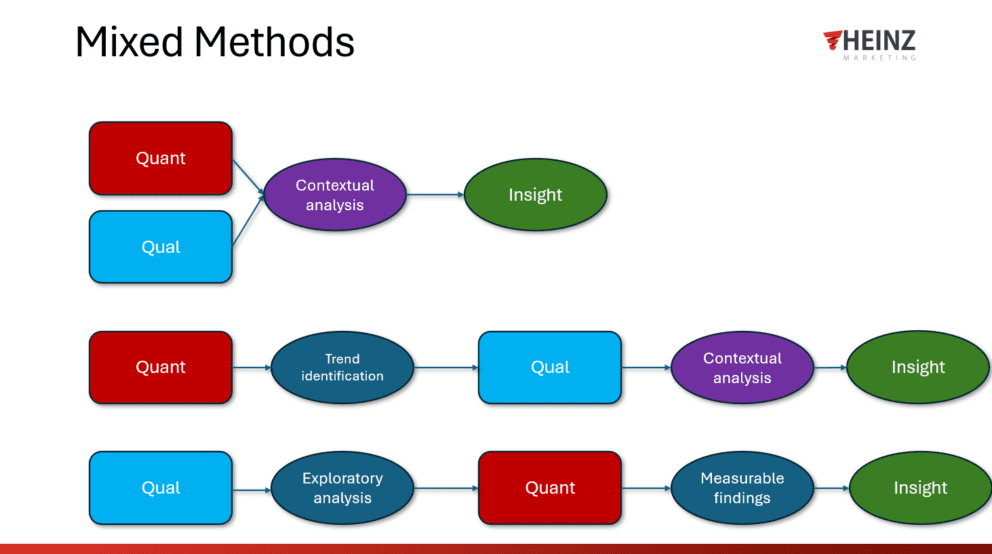Decoding the Customer Journey: A Guide to Effective Marketing Attribution – Pt. 4

Summary
As the final part to this marketing attribution blog series Im focusing on the importance of scalability and flexibility in attribution models and the challenges many companies face to try and keep up with the ever-changing market. Learn about best practices for achieving scalability, such as adopting modular architectures, leveraging cloud infrastructure, and implementing efficient data processing techniques. Along with strategies for enhancing flexibility, including embracing open standards and APIs, incorporating machine learning, and creating continuous feedback loops.
By Carly Bauer, Marketing Consultant at Heinz Marketing
Optimizing Your Attribution Model: How to stay scalable and flexible
In today’s marketing landscape, attribution models are crucial tools that allow businesses to understand the customer journey and measure the effectiveness of various marketing channels. By accurately attributing conversions and sales to the appropriate touchpoints, companies can optimize their marketing strategies, allocate budgets more efficiently, and ultimately drive better business outcomes. However, as the volume of data and the number of marketing channels continue to grow, ensuring that your attribution model remains both scalable and flexible is essential. Employing key strategies such as adopting modular architectures, leveraging cloud infrastructure, and integrating machine learning can help businesses maintain the robustness and adaptability of their attribution models, allowing them to stay ahead in an ever-evolving market.
For a deeper dive into marketing attribution, including its different methodologies, how to create a sustainable strategy and build a successful model, I recommend checking out parts 1-3 below for additional insights.
- Part 1: What is marketing attribution
- Part 2: How to build and implement your attribution model
- Part 3: Creating a sustainable attribution strategy
If you’re looking for best practices and tips to better optimize your current attribution model, then you’re in the right place!
In this blog post you’ll learn about,
- Unexpected but common challenges of scalability and flexibility
- Best practices to scale effectively
- Strategies to remain flexible
- Supportive tools and technology
Let’s get started!
Challenges of Scalability and Flexibility
Scalability Issues
Handling large volumes of data
One of the primary challenges in scaling attribution models is managing large volumes of data. As companies grow, they accumulate vast amounts of data from various marketing channels, customer interactions, and sales transactions. This influx can overwhelm traditional data processing systems, leading to slow performance and increased costs. Companies struggle with this issue because their existing infrastructure might not be designed to handle such scale, resulting in bottlenecks and inefficiencies. Common signs of this problem include slow data processing times, frequent system crashes, and the inability to analyze data in real-time.
Ensuring performance and speed
Ensuring high performance and speed in attribution models is crucial for timely decision-making. However, as data volumes increase and models become more complex, maintaining speed can be difficult. Companies often face this challenge when their systems lack the computational power or optimized algorithms necessary for rapid data analysis. Symptoms of performance issues include, delayed reporting, lag in data updates, and difficulty in running complex queries or generating insights quickly.
Flexibility Issues
Adapting to new channels and data sources
The marketing landscape is constantly evolving, with new channels and data sources emerging regularly. Attribution models need to be flexible enough to incorporate these changes without significant reconfiguration. Companies struggle with this adaptability due to rigid system architectures or reliance on outdated technologies that don’t support easy integration of new data types. Signs that a company is facing this challenge include difficulties in integrating social media metrics, new ad platforms, or emerging technologies like IoT and AI-driven insights into their existing attribution model.
Integrating with existing marketing technologies
Integration with existing marketing technologies is essential for a seamless attribution process. Many companies have a complex web of marketing tools and platforms, ranging from CRM systems to analytics tools and advertising networks. Ensuring that the attribution model integrates smoothly with these systems can be challenging, particularly if the technologies are not designed to work together. Companies often face issues with data silos, where information is trapped in disparate systems, making it difficult to get a holistic view of marketing performance. Signs of integration problems include inconsistent data across platforms, manual data entry, and frequent discrepancies in reports.
Why companies struggle with these issues
Companies often struggle with these scalability and flexibility challenges because of a combination of outdated technology, lack of expertise, and resistance to change. Legacy systems may not support modern data processing needs, while a lack of skilled personnel can hinder the development and implementation of more efficient solutions. Additionally, organizational inertia can slow down the adoption of new technologies and processes, further exacerbating these issues.
To assess whether your company is facing these challenges, look for the following signs:
- Data Processing Delays: Noticeable lag in data processing and reporting.
- System Failures: Frequent crashes or system downtime during data-intensive operations.
- Integration Issues: Difficulty in merging data from new channels or technologies with existing systems.
- Manual Interventions: High reliance on manual processes to bridge gaps between disparate systems.
- Inconsistent Reporting: Discrepancies in data and reports from different marketing platforms.
- Slow Decision-Making: Delays in generating actionable insights due to slow data analysis.
Best Practices for Scalability
These best practices can help ensure your attribution models are robust and capable of handling large volumes of data efficiently, maintaining high performance and speed, and scaling as needed to meet growing demands.
Adopting a Modular Architecture
Benefits of Modularity in Attribution Models: Modular architecture involves designing your attribution model as a collection of independent, interchangeable components or modules. This approach offers several benefits:
- Scalability: Modules can be scaled independently based on the specific needs of each component. For instance, the data ingestion module can be scaled to handle high volumes of incoming data, while the analytics module can be optimized for complex calculations.
- Flexibility: New features or updates can be added to individual modules without disrupting the entire system, making it easier to adapt to changing requirements.
- Maintainability: Modular systems are easier to maintain and troubleshoot since issues can be isolated to specific components.
Utilizing Cloud Infrastructure
Advantages of Cloud Computing for Scalability: Leveraging cloud infrastructure can significantly enhance the scalability of your attribution model:
- Elasticity: Cloud platforms like AWS, Google Cloud, and Azure offer elastic computing resources that can be scaled up or down based on demand. This ensures that your system can handle peak loads without over-provisioning resources.
- Cost Efficiency: Pay-as-you-go pricing models help manage costs effectively by only charging for the resources you actually use.
- Global Reach: Cloud platforms provide global data centers, enabling faster data processing and reduced latency for users around the world.
Popular Cloud Platforms:
- Amazon Web Services (AWS): Offers a wide range of services for computing, storage, and analytics.
- Google Cloud Platform (GCP): Provides powerful tools for big data processing and machine learning.
- Microsoft Azure: Integrates well with existing Microsoft tools and services, offering robust solutions for enterprise needs.
Implementing Efficient Data Processing
Batch Processing vs. Real-Time Processing: Efficient data processing is crucial for scalability. Depending on your needs, you might choose between batch processing and real-time processing:
- Batch Processing: Suitable for large datasets that do not require immediate analysis. This method processes data in large chunks, optimizing resource usage and reducing costs. Examples include daily or weekly data aggregation tasks.
- Real-Time Processing: Necessary for applications requiring immediate insights and actions. This method processes data as it arrives, enabling quick decision-making. Examples include real-time user behavior tracking and instant campaign performance analysis.
Tools and Technologies for Efficient Data Handling:
- Apache Spark: A powerful open-source processing engine that supports batch and real-time data processing. It is designed for speed and ease of use.
- Hadoop: An open-source framework that allows for the distributed processing of large datasets across clusters of computers.
- BigQuery: A fully managed, serverless data warehouse offered by Google Cloud, designed to handle massive datasets with fast SQL queries.
Strategies for Flexibility
When your business is faced with evolving market conditions and technological advancements these strategies can help ensure your attribution models remain dynamic and effective by being flexible and adaptable through change.
Embracing Open Standards and APIs
Benefits of Open Standards: Open standards are publicly available specifications that ensure interoperability between different systems and technologies. By adhering to these standards, companies can:
- Enhance Compatibility: Ensure that their attribution models can easily integrate with various data sources and marketing platforms without requiring custom solutions.
- Future-Proof Systems: Adopt standards that are widely supported, reducing the risk of becoming obsolete as new technologies emerge.
- Facilitate Collaboration: Enable smoother collaboration with partners, vendors, and third-party service providers.
How APIs Enhance Flexibility: APIs (Application Programming Interfaces) allow different software systems to communicate with each other. Utilizing APIs can significantly boost the flexibility of attribution models by:
- Enabling Seamless Integration: Connect different marketing tools, CRM systems, and data sources effortlessly.
- Facilitating Data Exchange: Automate the flow of data between systems, ensuring that the attribution model has access to the latest information.
- Supporting Customization: Allow for custom integrations and extensions, making it easier to adapt to specific business needs and requirements.
Incorporating Machine Learning
Role of Machine Learning in Attribution: Machine learning (ML) can enhance the flexibility of attribution models by providing more accurate and adaptive analysis. Key benefits include:
- Improved Accuracy: ML algorithms can analyze vast amounts of data and identify patterns that traditional models might miss, leading to more precise attribution.
- Dynamic Adaptation: ML models can continuously learn and adapt to changes in consumer behavior and market conditions, ensuring that the attribution model remains relevant and effective.
- Personalization: Enable more granular and personalized attribution insights, tailoring strategies to individual customer journeys.
Examples of Machine Learning Models
- Regression Models: Used to predict the relationship between variables, helping to identify which marketing channels have the most significant impact on conversions.
- Classification Models: Categorize data into different segments, allowing for targeted analysis of different customer groups.
- Clustering Algorithms: Group similar data points together, uncovering hidden patterns and insights that can inform marketing strategies.
Creating a Feedback Loop
Importance of Continuous Improvement: A feedback loop involves regularly collecting and analyzing data to refine and improve the attribution model. This iterative process is crucial for maintaining flexibility and ensuring long-term success.
- Adapt to Changes: Continuously update the model to reflect new data, market trends, and customer behaviors.
- Identify Weaknesses: Regular feedback helps identify areas where the model may be underperforming or missing key insights, allowing for targeted improvements.
- Optimize Performance: Fine-tune the model based on real-world performance and feedback, enhancing its accuracy and relevance.
Methods for Collecting and Integrating Feedback
- Regular Performance Reviews: Conduct periodic assessments of the attribution model’s accuracy and effectiveness, using key performance indicators (KPIs) to measure success.
- User Feedback: Gather input from stakeholders, including marketing teams, sales departments, and executives, to understand their needs and challenges.
- A/B Testing: Implement A/B tests to compare different attribution models or adjustments, using data-driven results to guide improvements.
Tools and Technologies for Optimizing Attribution Models
Data Processing and Storage
Hadoop: Hadoop is an open-source framework designed for distributed storage and processing of large datasets across clusters of computers. It is particularly effective for handling big data applications due to its scalability and fault tolerance.
Apache Spark: Apache Spark is an open-source data processing engine known for its speed and ease of use. It supports both batch and real-time processing and can handle complex computations efficiently.
BigQuery: BigQuery is a fully managed, serverless data warehouse provided by Google Cloud Platform (GCP). It is designed to handle large datasets quickly and efficiently.
Cloud Services
Amazon Web Services (AWS): AWS offers a comprehensive suite of cloud services that support various data processing and storage needs.
Google Cloud Platform (GCP): GCP provides a range of tools and services designed for scalable data processing and machine learning.
Microsoft Azure: Azure offers robust cloud services that integrate well with existing Microsoft tools and enterprise solutions.
Machine Learning Platforms
TensorFlow: TensorFlow is an open-source machine learning framework developed by Google. It is widely used for building and deploying machine learning models.
Scikit-learn: Scikit-learn is an open-source machine learning library for Python. It is known for its simplicity and efficiency, making it ideal for building and experimenting with machine learning models.
Amazon SageMaker: Amazon SageMaker is a fully managed service by AWS that enables developers and data scientists to build, train, and deploy machine learning models at scale.
APIs and Integration Tools
RESTful APIs: REST (Representational State Transfer) APIs are widely used for integrating different software systems by allowing them to communicate over HTTP.
Zapier: Zapier is an online automation tool that connects various apps and services, enabling them to work together seamlessly.
MuleSoft: MuleSoft provides a comprehensive integration platform for connecting applications, data, and devices.
Conclusion
Now that you understand the importance of scalability and flexibility in attribution models and the strategies to achieve them, it’s time to put these insights into action. Evaluate your current attribution model to identify any scalability or flexibility issues and consider adopting the best practices and tools discussed. Whether you’re looking to handle larger data volumes, integrate new marketing channels, or improve model accuracy, these strategies will help you build a robust and adaptable attribution model. Want some help? Reach out for a free brainstorm call.
Image by jannoon028 on Freepik






